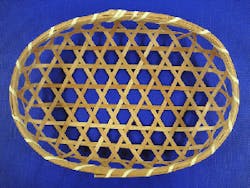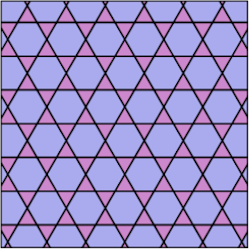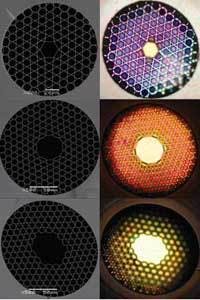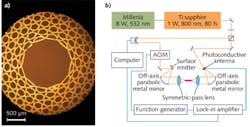
As our photonics industry continues to develop new and better fiber laser and supercontinuum laser sources, special optical fibers such as photonic crystal fibers (PCFs) are a hot topic. Of particular current interest is kagome optical fiber, so named because of its geometrical similarity to a traditional japanese woven bamboo basket. That is, the name kagome is derived from the japanese word kago meaning basket and me meaning eyes—a basket with eyes (see figure below and read more about the history of the word on Wikipedia at http://en.wikipedia.org/wiki/Trihexagonal_tiling):
A kagome lattice consists of an arrangement of shapes whereby two triangles and two hexagons surround every node of the lattice pattern in what is called a trihexagonal tiling (see below, again from Wikipedia):
The first mention of kagome in a scientific context was in 1951 (see http://scitation.aip.org/content/aip/magazine/physicstoday/article/56/2/10.1063/1.1564329), and the kagome form has been studied quite a bit in the context of physics theory and in such aesthetic forms as the Star of David on baskets and textiles. But as you probably know, in the photonics industry, the kagome structure has utility beyond a woven basket or a named geometrical form: it happens to be a very unique PCF lattice shape that works wonders for fiber-based laser sources.
In her keynote at the annual Laser Marketplace Seminar, Ursula Keller talked about how kagome fibers are enabling a new generation of ultrafast sources. And in September 2014, Laser Focus World published a feature article from Fetah Benabid and his team on how kagome lattice hollow-core PCF fibers are "the first photonic manifestation of a bound or quasi-bound state in a continuum" and helped lead to the development of hypocycloid core shape PCFs.
In a nutshell, the functional aspects of a kagome lattice are best explained in a short paragraph of a paper from RIKEN in Japan: The researchers used a hollow-core optical fiber with a structure known as a kagome lattice ... Atoms passing down the central channel of the hollow-core fiber are confined within the periodicity of this three-dimensional optical lattice. This confinement keeps the atoms isolated and protected from unwanted collisions with other atoms or the walls of the fiber, factors that have degraded the performance of similar approaches in the past. The optical lattice elegantly overcomes these problems and produces a minimally perturbed, voptically dense atomic sample with improved regularity or ‘coherence’.
Kagome has been the subject of numerous articles in Laser Focus World in recent years, including:
http://www.laserfocusworld.com/articles/print/volume-50/issue-09/features/fiber-for-fiber-lasers-kagome-pc-fiber-goes-to-extremes-for-ultrashort-pulse-lasers.html
http://www.laserfocusworld.com/articles/2014/07/single-mode-hollow-core-uv-optical-fibers-well-suited-for-many-types-of-spectroscopy.html
In a recent Optics Express paper, the future of kagome is summed in one short abstract sentence: Together with Yb-doped fiber amplifier technologies, Kagome fibers therefore appear as a promising tool for efficient generation of pulses with durations below 50 fs, energies ranging from 10 to several hundreds of µJ, and high average powers.
If your research team or company is doing any groundbreaking work in kagome-related science, let us know so we can publish a story and keep our readers informed.
About the Author

Gail Overton
Senior Editor (2004-2020)
Gail has more than 30 years of engineering, marketing, product management, and editorial experience in the photonics and optical communications industry. Before joining the staff at Laser Focus World in 2004, she held many product management and product marketing roles in the fiber-optics industry, most notably at Hughes (El Segundo, CA), GTE Labs (Waltham, MA), Corning (Corning, NY), Photon Kinetics (Beaverton, OR), and Newport Corporation (Irvine, CA). During her marketing career, Gail published articles in WDM Solutions and Sensors magazine and traveled internationally to conduct product and sales training. Gail received her BS degree in physics, with an emphasis in optics, from San Diego State University in San Diego, CA in May 1986.



